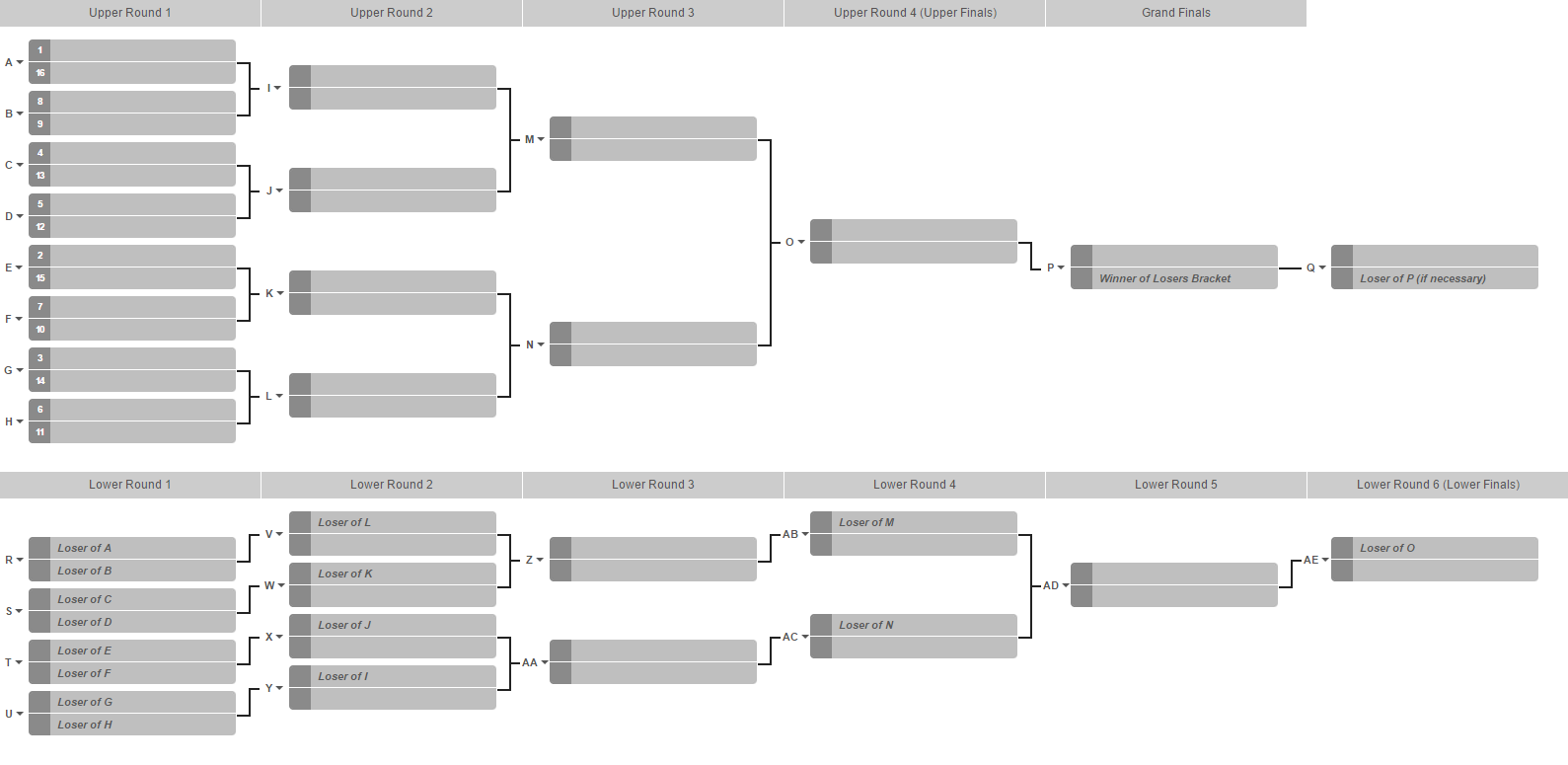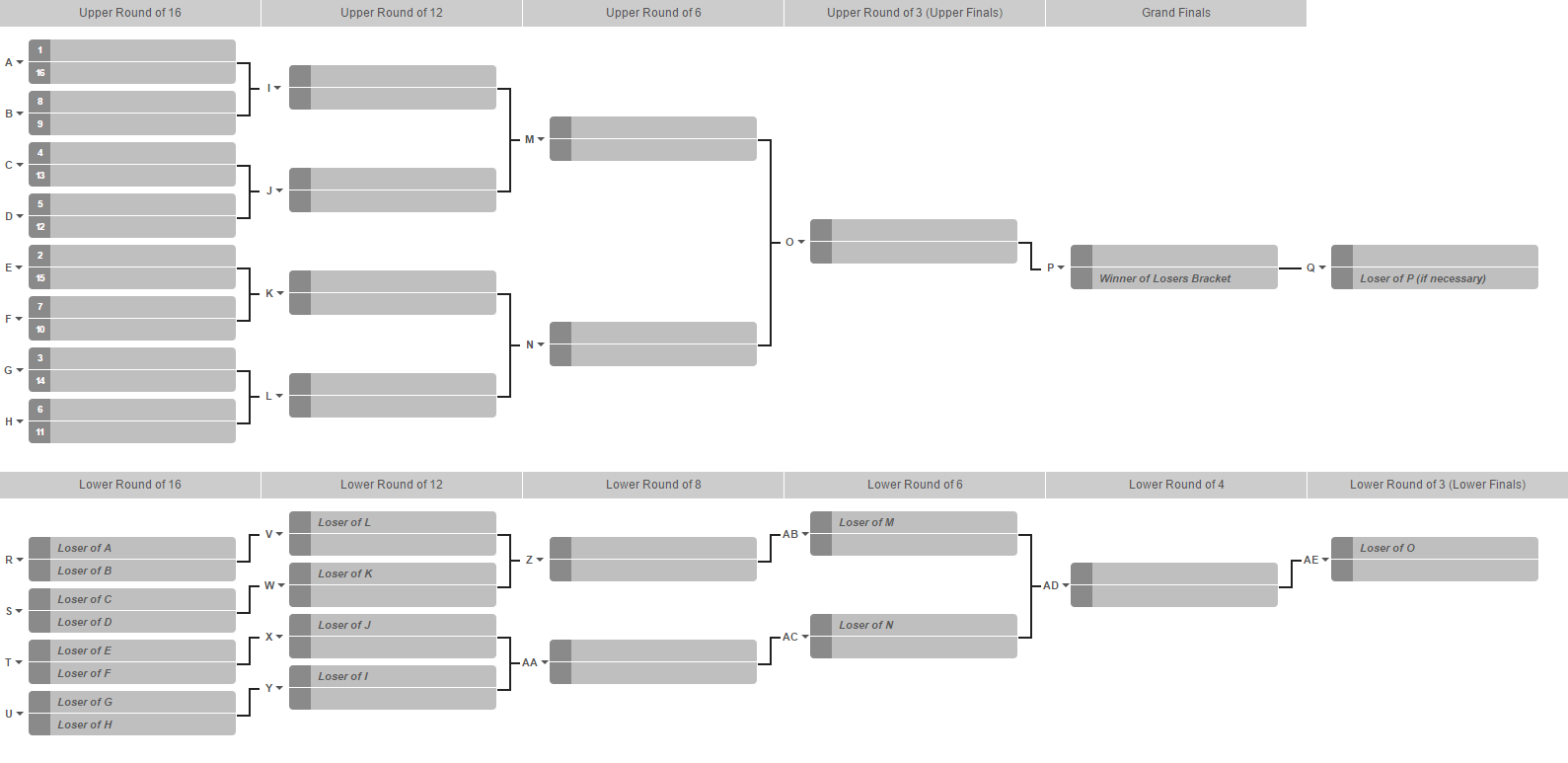Double Elimination Round Names
trying to make progress clearer
I tend to overanalyze and fixate on tournament structures a lot as part of my general fascination with hierarchies and orders. As a result, I tend to focus on mostly unimportant issues. The naming of double-elimination bracket rounds is one of those issues, and we’ll be discussing it here.
My main issue with the naming of the rounds in double-elimination brackets is that they usually don’t show progression very well.
Let’s take the example of the most common bracket round names, in which rounds are numbered according to their position in the upper or lower bracket:

The problem here is that round numbers in the upper bracket do not correspond well to round numbers in the lower bracket. At the beginning they do match, as upper round 1 feeds into lower round 1 and upper round 2 feeds into lower round 2, but they quickly desync, with upper round 3 feeding into lower round 4. The difference quickly grows with the bracket size, as each round in the upper bracket will correspond with two rounds in the lower bracket (after the first two rounds, of course). Of course, this is readily familiar to anyone who has been acquainted with double-elimination brackets before, but is a completely foreign concept to anyone who isn’t, and even those experienced with double-elimination will most likely have to refer to one in order to figure out which upper round goes with each lower round. In short, it’s simple, but it also isn’t very clear.
Of course, that was the most common usage, incidentally also the most sane out of the many formats I’ve seen due to its consistency. It is very common to refer to the last round in the upper and lower brackets as the final of the bracket, which is a perfectly acceptable alternative. However, this is sometimes extended to call the second-to-last round the semifinal, the third-to-last round the quarterfinal, and so on. This somewhat works for the upper bracket considering it is the closest to a single-elimination bracket, but causes several complications when used in the lower bracket (as there won’t be two semifinals, four quarterfinals, etc. in the lower bracket), and only using it for the upper bracket causes confusion. Another irking variation I’ve seen is calling the second-to-last round in the lower bracket the lower final and the last round the consolation final - it’s justified by the fact that the last round of the lower bracket is a match which determines third place, similar to a consolation final in a single-elimination format, but I heavily dislike it because it’s ignoring the workings of the double-elimination bracket in favor of a single-elimination bracket convention.
So what would I consider the ideal format for round names? It’s derived from how rounds in single-elimination brackets can be called by number of participants in the round - in a 16-team elimination bracket, the first round would be the round of 16, the second round the round of 8, and so on. This is sometimes applied to double-elimination brackets, but it suffers from the same problems I discuss above, in addition to the fact that participating in the upper “round of 8” doesn’t necessarily mean that a participant will be in the top 8 (in particular, if they lose that game and then lose their next game in the lower bracket, they finish 9th-12th, which is not in the top 8). However, adjusting the numbers to reflect the minimum finish a team can have allows us to do the following:

This more accurately reflects progression through the bracket - a participant in the upper “round of 12” is guaranteed a top 12 finish, and a participant in the lower “round of 8” is guaranteed a top 8 finish. It also lends itself well to accurately understanding how participants drop - losers in the upper “round of 6” will drop to the lower “round of 6” (whereas in the other system the same upper round 3 would drop into lower round 4). The main disadvantage that I could see is that these names don’t accurately represent the number of participants and games in the individual brackets - the upper “round of 12” only has 8 participants and 4 games - but I feel that it’s a relatively minor disadvantage compared to the many advantages gained. Of course, there is also the minor detail that these names are a bit more complex than the simple round numbers, which would definitely impede their adoption… but hey, I can dream.
